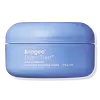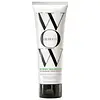What's inside
What's inside
 Key Ingredients
Key Ingredients

No key ingredients
 Benefits
Benefits

 Concerns
Concerns

 Ingredients Side-by-side
Ingredients Side-by-side

Water
Skin ConditioningEuphorbia Cerifera Wax
Ricinus Communis Seed Oil
MaskingGlycerin
HumectantPolyhydroxystearic Acid
EmulsifyingCetearyl Alcohol
EmollientTribehenin
EmollientPullulan
Lauryl Laurate
Skin ConditioningCeteareth-20
CleansingKaolin
AbrasiveParfum
MaskingPrunus Domestica Seed Oil
Skin ConditioningHelianthus Annuus Seed Oil
EmollientButyrospermum Parkii Butter
Skin ConditioningPanthenol
Skin ConditioningJojoba Esters
EmollientNiacinamide
SmoothingFolic Acid
Skin ConditioningPyridoxine Hcl
Skin ConditioningRosa Canina Fruit Oil
EmollientBiotin
AntiseborrhoeicCamellia Oleifera Seed Oil
Skin ConditioningSodium Carbonate
BufferingStearic Acid
CleansingOryza Sativa Bran Wax
Skin ConditioningCarbomer
Emulsion StabilisingHydroxystearic/Linolenic/Oleic Polyglycerides
EmollientCitrus Junos Peel Extract
Skin ConditioningTocopherol
AntioxidantSodium Hydroxide
BufferingCaprylhydroxamic Acid
Benzyl Alcohol
PerfumingWater, Euphorbia Cerifera Wax, Ricinus Communis Seed Oil, Glycerin, Polyhydroxystearic Acid, Cetearyl Alcohol, Tribehenin, Pullulan, Lauryl Laurate, Ceteareth-20, Kaolin, Parfum, Prunus Domestica Seed Oil, Helianthus Annuus Seed Oil, Butyrospermum Parkii Butter, Panthenol, Jojoba Esters, Niacinamide, Folic Acid, Pyridoxine Hcl, Rosa Canina Fruit Oil, Biotin, Camellia Oleifera Seed Oil, Sodium Carbonate, Stearic Acid, Oryza Sativa Bran Wax, Carbomer, Hydroxystearic/Linolenic/Oleic Polyglycerides, Citrus Junos Peel Extract, Tocopherol, Sodium Hydroxide, Caprylhydroxamic Acid, Benzyl Alcohol
Water
Skin ConditioningPropylene Glycol
HumectantPersea Gratissima Oil
Skin ConditioningPhenyl Trimethicone
Skin ConditioningGlycerin
HumectantIsostearyl Palmitate
EmollientGlyceryl Stearate
EmollientC12-15 Alkyl Benzoate
AntimicrobialEthylhexyl Salicylate
UV AbsorberSorbitan Oleate
EmulsifyingParfum
MaskingAcrylates/C10-30 Alkyl Acrylate Crosspolymer
Emulsion StabilisingMyristamidopropyl Pg-Dimonium Chloride Phosphate
Skin ConditioningAminomethyl Propanol
BufferingSteardimonium Hydroxypropyl Hydrolyzed Wheat Protein
Skin ConditioningPhenoxyethanol
PreservativeCaprylyl Glycol
EmollientEthylhexylglycerin
Skin ConditioningButylene Glycol
HumectantLinalool
PerfumingHexyl Cinnamal
PerfumingCitronellol
PerfumingWater, Propylene Glycol, Persea Gratissima Oil, Phenyl Trimethicone, Glycerin, Isostearyl Palmitate, Glyceryl Stearate, C12-15 Alkyl Benzoate, Ethylhexyl Salicylate, Sorbitan Oleate, Parfum, Acrylates/C10-30 Alkyl Acrylate Crosspolymer, Myristamidopropyl Pg-Dimonium Chloride Phosphate, Aminomethyl Propanol, Steardimonium Hydroxypropyl Hydrolyzed Wheat Protein, Phenoxyethanol, Caprylyl Glycol, Ethylhexylglycerin, Butylene Glycol, Linalool, Hexyl Cinnamal, Citronellol
Ingredients Explained
These ingredients are found in both products.
Ingredients higher up in an ingredient list are typically present in a larger amount.
Glycerin is already naturally found in your skin. It helps moisturize and protect your skin.
A study from 2016 found glycerin to be more effective as a humectant than AHAs and hyaluronic acid.
As a humectant, it helps the skin stay hydrated by pulling moisture to your skin. The low molecular weight of glycerin allows it to pull moisture into the deeper layers of your skin.
Hydrated skin improves your skin barrier; Your skin barrier helps protect against irritants and bacteria.
Glycerin has also been found to have antimicrobial and antiviral properties. Due to these properties, glycerin is often used in wound and burn treatments.
In cosmetics, glycerin is usually derived from plants such as soybean or palm. However, it can also be sourced from animals, such as tallow or animal fat.
This ingredient is organic, colorless, odorless, and non-toxic.
Glycerin is the name for this ingredient in American English. British English uses Glycerol/Glycerine.
Learn more about GlycerinParfum is a catch-all term for an ingredient or more that is used to give a scent to products.
Also called "fragrance", this ingredient can be a blend of hundreds of chemicals or plant oils. This means every product with "fragrance" or "parfum" in the ingredients list is a different mixture.
For instance, Habanolide is a proprietary trade name for a specific aroma chemical. When used as a fragrance ingredient in cosmetics, most aroma chemicals fall under the broad labeling category of “FRAGRANCE” or “PARFUM” according to EU and US regulations.
The term 'parfum' or 'fragrance' is not regulated in many countries. In many cases, it is up to the brand to define this term.
For instance, many brands choose to label themselves as "fragrance-free" because they are not using synthetic fragrances. However, their products may still contain ingredients such as essential oils that are considered a fragrance by INCI standards.
One example is Calendula flower extract. Calendula is an essential oil that still imparts a scent or 'fragrance'.
Depending on the blend, the ingredients in the mixture can cause allergies and sensitivities on the skin. Some ingredients that are known EU allergens include linalool and citronellol.
Parfum can also be used to mask or cover an unpleasant scent.
The bottom line is: not all fragrances/parfum/ingredients are created equally. If you are worried about fragrances, we recommend taking a closer look at an ingredient. And of course, we always recommend speaking with a professional.
Learn more about ParfumWater. It's the most common cosmetic ingredient of all. You'll usually see it at the top of ingredient lists, meaning that it makes up the largest part of the product.
So why is it so popular? Water most often acts as a solvent - this means that it helps dissolve other ingredients into the formulation.
You'll also recognize water as that liquid we all need to stay alive. If you see this, drink a glass of water. Stay hydrated!
Learn more about Water